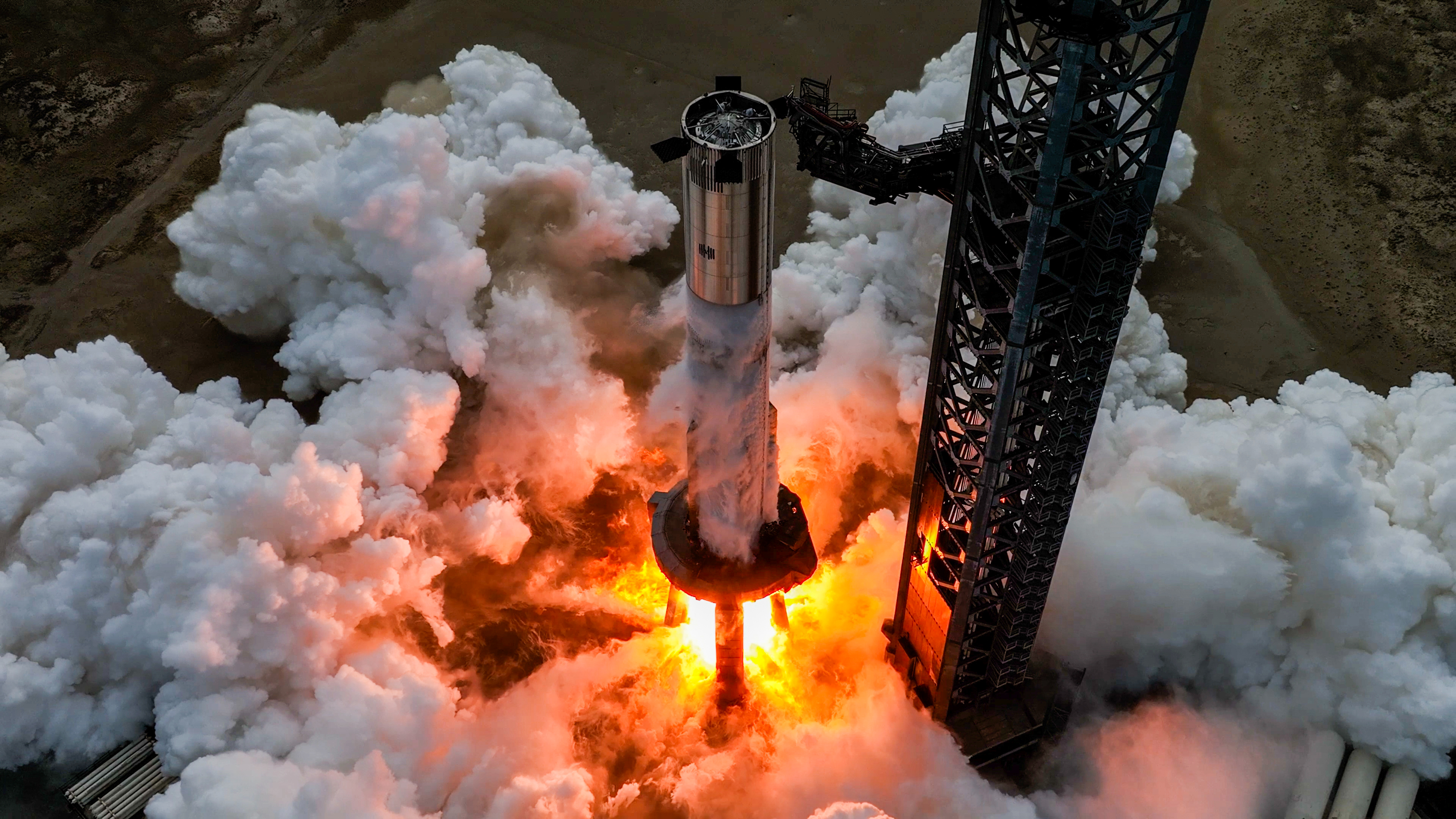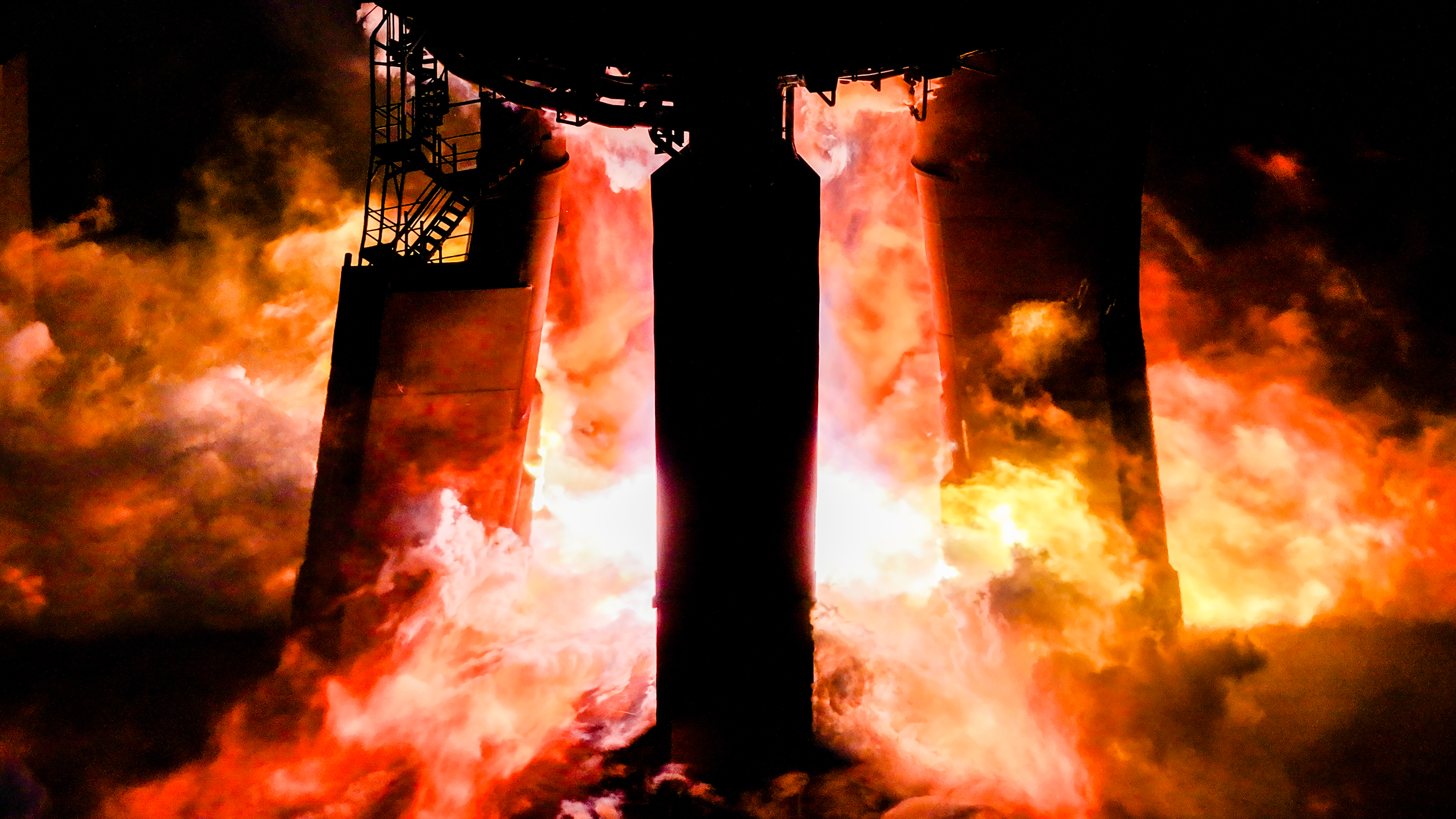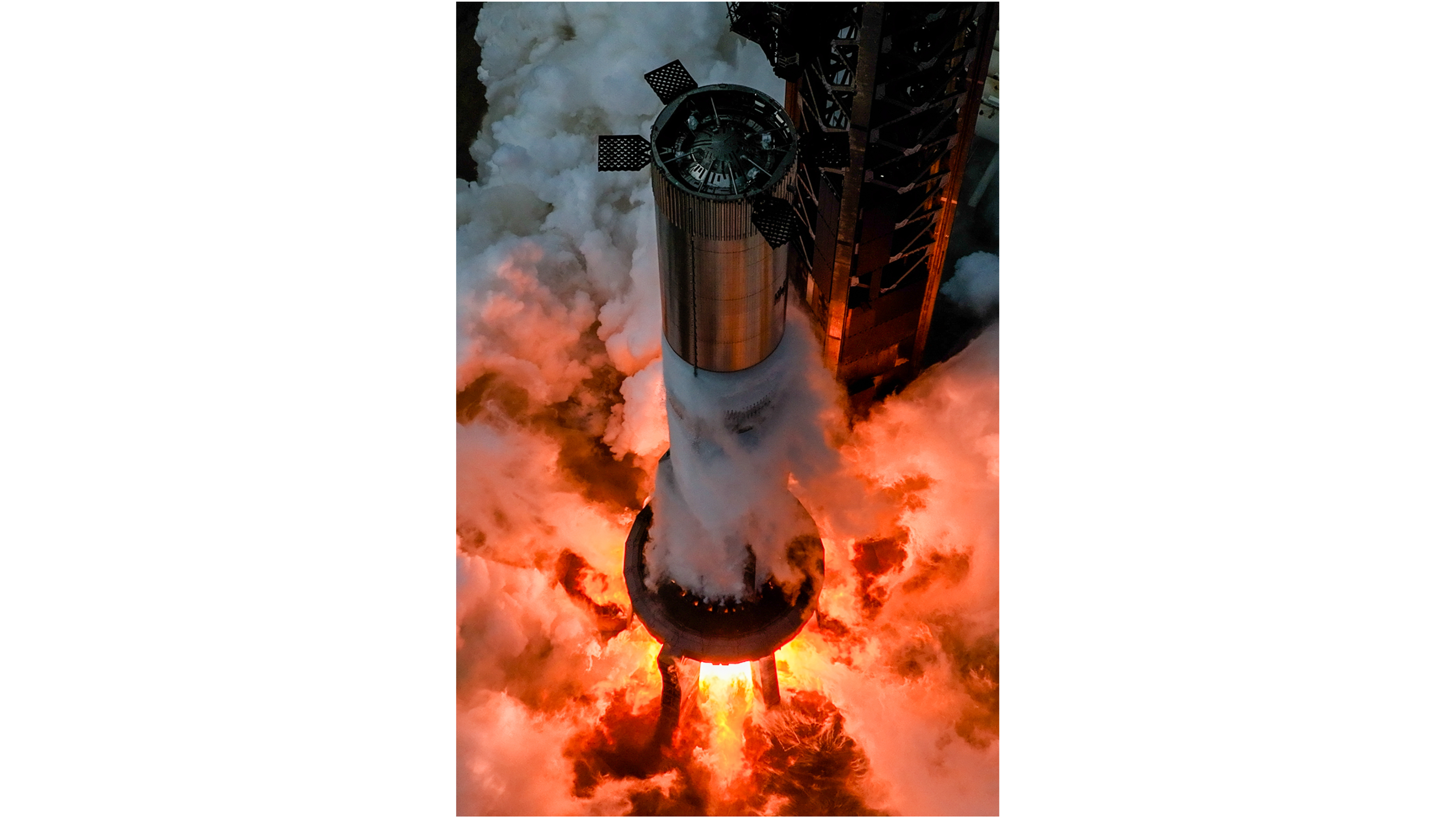SpaceX is gearing up for the seventh test flight of its Starship megarocket, which could take place in just a month or so.
The company conducted a static-fire test with Flight 7's Super Heavy first-stage booster today (Dec. 9), briefly igniting its 33 Raptor engines at a pad at SpaceX's Starbase facility in South Texas.
The company documented the milestone on X today, posting three photos and a short video of the test.

SpaceX has not yet announced a launch date for Starship's seventh test flight, but the company appears to be eyeing Jan. 11; an email sent by NASA to the U.S. Federal Aviation Administration identifies that date as the target. (According to that email, NASA plans to deploy a Gulfstream V jet to observe the upcoming flight.)
Related: What's next for SpaceX's Starship after its successful 6th test flight?
Starship consists of two stainless-steel stages, both of which are designed to be fully and rapidly reusable. The upper stage is a 165-foot-tall (50 meters) spacecraft known as Starship, or just Ship.
When Ship is stacked atop Super Heavy, Starship stands about 400 feet (122 m) tall — bigger that any other rocket in history. Starship is also the most powerful launcher ever built, boasting nearly twice the liftoff thrust of NASA's Space Launch System moon rocket.
Get the Space.com Newsletter
Breaking space news, the latest updates on rocket launches, skywatching events and more!

Starship's six test flights to date occurred in April and November of 2023 and March, June, October and November of this year.
The megarocket has performed quite well, especially on its last two missions. On each occasion, both Super Heavy and Ship made it to space as planned and survived their trip back down to Earth in one piece.

And, on Flight 5, Super Heavy returned safely to its launch tower, which caught the booster using its "chopstick" arms — the strategy SpaceX plans to use eventually for both Super Heavy and Ship, to make reflight as quick and efficient as possible.
SpaceX aimed to repeat the booster catch on Flight 6, but communication issues with the tower scuttled that try, and Super Heavy diverted to splash down in the Gulf of Mexico.
Join our Space Forums to keep talking space on the latest missions, night sky and more! And if you have a news tip, correction or comment, let us know at: community@space.com.

Michael Wall is a Senior Space Writer with Space.com and joined the team in 2010. He primarily covers exoplanets, spaceflight and military space, but has been known to dabble in the space art beat. His book about the search for alien life, "Out There," was published on Nov. 13, 2018. Before becoming a science writer, Michael worked as a herpetologist and wildlife biologist. He has a Ph.D. in evolutionary biology from the University of Sydney, Australia, a bachelor's degree from the University of Arizona, and a graduate certificate in science writing from the University of California, Santa Cruz. To find out what his latest project is, you can follow Michael on Twitter.
-
jan.wolitzky "The megarocket has performed quite well"? As long as "performing well" doesn't include ever achieving orbit, or ever recovering the "designed to be fully reusable" Starship.Reply -
Philly Reply
Orbit isn't anything that would be considered to be important at this point since they aren't placing any payloads into orbit yet. Until they have a very high degree of certainty as far as being able to control the Starship in orbit it is safer to just dump it into the Ocean. If it went out of control and crashed into a populated area that wouldn't be worth the risk at this point.jan.wolitzky said:"The megarocket has performed quite well"? As long as "performing well" doesn't include ever achieving orbit, or ever recovering the "designed to be fully reusable" Starship.
Understand to land it back at the Cape or in Texas it will have to fly in across or over top of populated areas. Having one crash on top of Disney World just because you didn't test it fully would be a very bad thing. Best to eliminate as many doubts as possible now, with extensive real world testing.
Besides SX knows how to put stuff into orbit at this point. -
jan.wolitzky Delivering payloads to orbit is the whole point. Let's compare Starship to the 60-year old technology everyone most likes to compare it to, the Saturn V. That craft put a payload into orbit on its first flight. No wasting time fooling around with partially successful suborbital demos. Starship/SuperHeavy just had it's sixth flight. On Saturn V's sixth flight, it sent Apollo 11 to the moon.Reply
For Starship HLS to land astronauts on the moon (now slated for 2027, but there's no way that will happen), SpaceX will need to orbit a Starship tanker, then orbit a series of Starships (a number in the "high teens", per NASA) to fuel the tanker, then orbit Starship HLS (Human Landing System) to receive fuel from the tanker, then fire Starship HLS into a translunar trajectory, then drop it into lunar orbit, where it will dock with either Artemis 3 or with the Lunar Gateway, from which astronauts will transfer, then deorbit and descend to the surface, then lift off, achieve lunar orbit, and dock again to deliver astronauts for the return trip. (After which, the fuel-depleted Starship HLS will be abandoned, not reused.) That's an awful lot of capabilities that have yet to be demonstrated! -
skynr13 Reply
Or having the legs it will needs to land on the Moon. Chopstik catches are fine, but it will still need legs to land on other planets or moons. It would be especially fine now, as it would facilitate it's landing even on Earth during testing and check one more test off the books before regular use and end these pollutive sea landings.jan.wolitzky said:"The megarocket has performed quite well"? As long as "performing well" doesn't include ever achieving orbit, or ever recovering the "designed to be fully reusable" Starship. -
skynr13 Reply
It still cannot land on the Moon without landing legs. So why isn't that being introduced now for testing?jan.wolitzky said:Delivering payloads to orbit is the whole point. Let's compare Starship to the 60-year old technology everyone most likes to compare it to, the Saturn V. That craft put a payload into orbit on its first flight. No wasting time fooling around with partially successful suborbital demos. Starship/SuperHeavy just had it's sixth flight. On Saturn V's sixth flight, it sent Apollo 11 to the moon.
For Starship HLS to land astronauts on the moon (now slated for 2027, but there's no way that will happen), SpaceX will need to orbit a Starship tanker, then orbit a series of Starships (a number in the "high teens", per NASA) to fuel the tanker, then orbit Starship HLS (Human Landing System) to receive fuel from the tanker, then fire Starship HLS into a translunar trajectory, then drop it into lunar orbit, where it will dock with either Artemis 3 or with the Lunar Gateway, from which astronauts will transfer, then deorbit and descend to the surface, then lift off, achieve lunar orbit, and dock again to deliver astronauts for the return trip. (After which, the fuel-depleted Starship HLS will be abandoned, not reused.) That's an awful lot of capabilities that have yet to be demonstrated! -
Classical Motion Saturn was built under military threat. Musk is building under bureaucratic threat.Reply
And I love his demonstrations. I have no doubt he can build gas stations in earth and moon orbit.
Service with a smile. -
DrRaviSharma Some of these suggestions probably can help SpaceX team as they donot have and think that they do not need experience of previous moon missions.Reply
Product improvement is desired esecially with taxpayer money based projects.
Even if Starship is ready is Artemis Next human mission close?
Also we donot need delays due to extraneous complexities such as gateways that can evolve later.
Yes randezvous with Orion, Landing and ascent to moon if Starship is to be used should be prioity other long term survival on moon should be extended parts of core revisit mission.
I was for 5 years part of NASA HQ Apollo Program.
Thanks -
jan.wolitzky NASA is losing confidence in SpaceX's ability to deliver on their cockamamie multi-step Starship HLS plan. Last Spring, they started talking about maybe having Artemis 3 not land astronauts on the moon, but just dock with Starship in low Earth orbit. (For comparison, the similar Apollo 9 mission followed the more ambitious Apollo 8 by less than 3 months.) https://arstechnica.com/space/2024/04/nasa-may-alter-artemis-iii-to-have-starship-and-orion-dock-in-low-earth-orbit/Reply -
Philly Reply
Even if NASA had 10 Saturn V's and 10 Apollo era LEM's also in storage it wouldn't mean squat. It would still mean that NASA and mankind still would be at the same dead end Apollo faced in 1972. We still have sealed bags of Moon rocks we haven't touched yet from the 1st Apollo missions.jan.wolitzky said:Delivering payloads to orbit is the whole point. Let's compare Starship to the 60-year old technology everyone most likes to compare it to, the Saturn V. That craft put a payload into orbit on its first flight. No wasting time fooling around with partially successful suborbital demos. Starship/SuperHeavy just had it's sixth flight. On Saturn V's sixth flight, it sent Apollo 11 to the moon.
For Starship HLS to land astronauts on the moon (now slated for 2027, but there's no way that will happen), SpaceX will need to orbit a Starship tanker, then orbit a series of Starships (a number in the "high teens", per NASA) to fuel the tanker, then orbit Starship HLS (Human Landing System) to receive fuel from the tanker, then fire Starship HLS into a translunar trajectory, then drop it into lunar orbit, where it will dock with either Artemis 3 or with the Lunar Gateway, from which astronauts will transfer, then deorbit and descend to the surface, then lift off, achieve lunar orbit, and dock again to deliver astronauts for the return trip. (After which, the fuel-depleted Starship HLS will be abandoned, not reused.) That's an awful lot of capabilities that have yet to be demonstrated!
Going back to the Moon in the 2020-30's is NOT about doing a re-enactment of the Apollo landings objectives of planting a flag, taking selfies and grabbing a few rocks. That is NOT mankind's next great leap forward.
Without being able to land 100's or 1000's of tons of equipment on the Moon there is nothing happening beyond doing the Apollo did. During this phase of Lunar exploration, finding ice water in the deep craters at the south pole seems to be the real objective but that is only phase 1.
After finding that Ice...Phase 2, would be building the infrastructure to access and process that ice would be next. Not know exactly what is in those craters, how to attack the processing the ice is an unknown. No matter how you look at it, that phase also is a project that also requires 1000's of tons of equipment. After that there would be additional phases of 3, 4 and 5. Guess what that will require?
Then you can't ignore the reality of using an expendable SLS 2 stage rocket that costs $4 billion every launch is not the right tool for this job. It doesn't have the capability that the Sat V had, it is only a 2 stage rocket. And we've already burnt what, $20 billion on R&D for SLS?
Face the cold shower reality of physics and the cold shower reality of a realistic working budget. Ares has already spent 10's of billions and that didn't include any kind of lander. NASA painted themselves into a corner. They only had 1 card to play.
SX was building their Mars lander with Starship. NASA called SX to bail them out because there is no other option for a lander. I mean what was NASA going to do, ask Blue or Boeing to build one? I mean Blue hasn't been able to put anything into LEO after 25 years. A lunar lander? Haha, 15 years sounds reasonable. As for Boeing, in 2024 a crew capsule isn't really anything new considering we have been building capsules since the early 1960's but Boeing can't get it done.
NASA, "Hey Elon can we use Starship as a lunar lander?" Elon, "Sure, but understand we're not delaying out Mars lander project to build your Lunar lander." NASA, "Okay but we need to tell the public and the media that is will happen sooner." Elon, "sure but we all know if I land anything on Mars everyone will forget about going back to the Moon." NASA, "Of course but this is how the game is played".
So taking that into account, please explain what the problems are with SX's Starship again? A fully reusable system is a massive challenge but what other options are there that we're all missing? Also what other option besides orbital refueling is there? -
DrRaviSharma As long as P and Q are separate projects and accounting is kept in accordance with US OMB or congressional oversight then there should not be negative influence of say self funded Mars mission vs Federally funded Moon or Artemis mission.Reply
One can use capabilities to reduce costs.
Let us not forget that it was vision of SpaceX that bailed us out of Russian launch dependence and so we always need at least one alternative or backup.
Lunar missions funded under Artemis should have priority over other company programs if there is resource allocation issue.
Fortunately the Genius person has kept all guesses behind and accomplished ahead.
He is not Werner Von Braun the Most accomplished Rocket leader, but he certainly is one thereafter and may beat all records.
My worry is multiple roles, related political and private enterprise role conflicts, as some had brought up between Solar and Tesla enterprise boards ownership?
What mechanisms are in place for runaway situation with conflict of interest and are those executable? Once again he and SpaceX may rise again above all that!
Best to SpaceX and at least one more competitor or alternate for Artemis and Lunar Exploration. Best for parallel Mars missions deemed safe on risk evaluation basis.
Regards
Ravi









